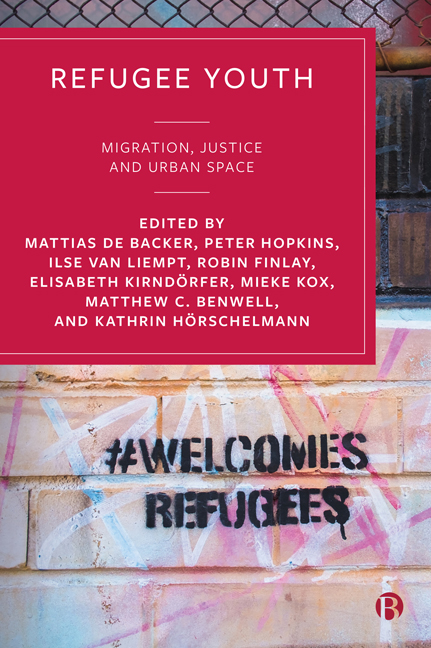Book contents
- Frontmatter
- Contents
- List of Figures and Tables
- Notes on Contributors
- Acknowledgements
- 1 Introducing Refugee Youth: Migration, Justice and Urban Space
- 2 Storying Belonging, Enacting Citizenship? (Dis)articulations of Belonging in a Community Theatre Project with Young Refugees and Asylum Seekers in Leipzig, Germany
- 3 Jackets and Jewellery: Racialised Dispossession and Struggles over Public Space in Denmark
- 4 Venezuelan Refugee Youth and Brazilian Schooling: The Individual between Languages and Spaces
- 5 The Inclusionary Potential and Spatial Boundaries of (Semi-)Public Space: Refugee Youth’s Everyday Experiences in the Urban Fabric of Amsterdam
- 6 Navigating ‘Purdah’ Culture in Urban Space: The Restricted Lives of Young Married Rohingya Refugees in Malaysia
- 7 Inclusive Urban Planning and Public Space for Refugee Youth in Pursuit of a Just City in Amman, Jordan
- 8 Sense of Belonging among Tibetan Refugees in India: A Case Study of the Bylakuppe Settlement in Karnataka, India
- 9 Negotiating Identity in Urban Space: Everyday Geographies of Syrian Students in Istanbul
- 10 ‘You’re Judged a Lot’: Australian Sudanese and South Sudanese Youths’ Perspectives on Their Experiences in Public Spaces
- 11 Hair Salons as ‘Private-Public Spaces’: Exploring the Experiences of Young Migrant Women in an Urban Township in South Africa
- 12 Emotion and Spatial Belonging: Exploring Young Migrant Men’s Emotional Geographies in Cork, Ireland
- 13 Homemaking through Music in Urban Africa: Creating Opportunities as a Refugee and a Migrant in Kinshasa and Dar es Salaam
- 14 Planetary Listening
- 15 Refugee Youth: Politics, Publicness and Visibility
- Index
10 - ‘You’re Judged a Lot’: Australian Sudanese and South Sudanese Youths’ Perspectives on Their Experiences in Public Spaces
Published online by Cambridge University Press: 18 January 2024
- Frontmatter
- Contents
- List of Figures and Tables
- Notes on Contributors
- Acknowledgements
- 1 Introducing Refugee Youth: Migration, Justice and Urban Space
- 2 Storying Belonging, Enacting Citizenship? (Dis)articulations of Belonging in a Community Theatre Project with Young Refugees and Asylum Seekers in Leipzig, Germany
- 3 Jackets and Jewellery: Racialised Dispossession and Struggles over Public Space in Denmark
- 4 Venezuelan Refugee Youth and Brazilian Schooling: The Individual between Languages and Spaces
- 5 The Inclusionary Potential and Spatial Boundaries of (Semi-)Public Space: Refugee Youth’s Everyday Experiences in the Urban Fabric of Amsterdam
- 6 Navigating ‘Purdah’ Culture in Urban Space: The Restricted Lives of Young Married Rohingya Refugees in Malaysia
- 7 Inclusive Urban Planning and Public Space for Refugee Youth in Pursuit of a Just City in Amman, Jordan
- 8 Sense of Belonging among Tibetan Refugees in India: A Case Study of the Bylakuppe Settlement in Karnataka, India
- 9 Negotiating Identity in Urban Space: Everyday Geographies of Syrian Students in Istanbul
- 10 ‘You’re Judged a Lot’: Australian Sudanese and South Sudanese Youths’ Perspectives on Their Experiences in Public Spaces
- 11 Hair Salons as ‘Private-Public Spaces’: Exploring the Experiences of Young Migrant Women in an Urban Township in South Africa
- 12 Emotion and Spatial Belonging: Exploring Young Migrant Men’s Emotional Geographies in Cork, Ireland
- 13 Homemaking through Music in Urban Africa: Creating Opportunities as a Refugee and a Migrant in Kinshasa and Dar es Salaam
- 14 Planetary Listening
- 15 Refugee Youth: Politics, Publicness and Visibility
- Index
Summary
Introduction
This chapter explores Australian Sudanese and South Sudanese youths’ perspectives on their experiences within public spaces in the city of Melbourne. Australia has large Sudanese and South Sudanese communities, with the city of Melbourne being ‘home to the largest number of Sudan-or South Sudan-born residents’ (Robinson, 2013, p 22). Since the early 2000s, approximately 50,000 people from sub-Saharan African nations have been settled in Australia under the country's Humanitarian Entrant Programme for refugees (DSS, 2016; Baak, 2019). It is important to note that for many of these individuals at their time of birth (and later at their time of entry into Australia), South Sudan was not recognised as a nation state. It has since become the world's youngest nation state, officially gaining independence in 2011. Of these 50,000 individuals, more than half identified their country of birth as Sudan or South Sudan (DSS, 2016; Baak, 2019). In Australia, many young people from these communities are socially and educationally thriving (Harris et al, 2013; Santoro and Wilkinson, 2016). However, others experience a variety of social, political, educational and familial challenges throughout the youth years (Abur and Spaaij, 2016; Deng, 2016). Chief among these challenges are the influence and consequences of negative racialised public and political attention experienced by these youth, which frames these young people as dangerous ‘outsiders’ (Benier et al, 2018; Macaulay and Deppeler, 2020b).
To better understand the broader social and political context of this negative racialised attention, it is important to contextualise this attention within Australia's broader settlement and migration history. As a relatively young nation state, Australia has a contentious colonial history, with a denial of traditional Indigenous ownership of land (Due, 2008). Additionally, under Australia's Immigration Restriction Act 1901 (colloquially known as the ‘white Australia policy’ and formally removed from government in 1973), patterns of migration were heavily regulated and ‘restricted any legal nonwhite immigration’ (Benier et al, 2021, p 224). Against the backdrop of the country's colonial and migration history, ‘Australian identity’ has been socially and political positioned as being those from Anglo-Celtic (and similar European) backgrounds (Ahluwalia, 2001; Macaulay and Deppeler, 2020b). Therefore, it has been argued that through an ongoing ‘colonial objective to make Australia a white country and for white people’ (Majavu, 2017, p 6), Australian communities with sub-Saharan African heritage are often cast as ‘Black others’ in ‘White Australia’.
- Type
- Chapter
- Information
- Refugee YouthMigration, Justice and Urban Space, pp. 153 - 168Publisher: Bristol University PressPrint publication year: 2023



